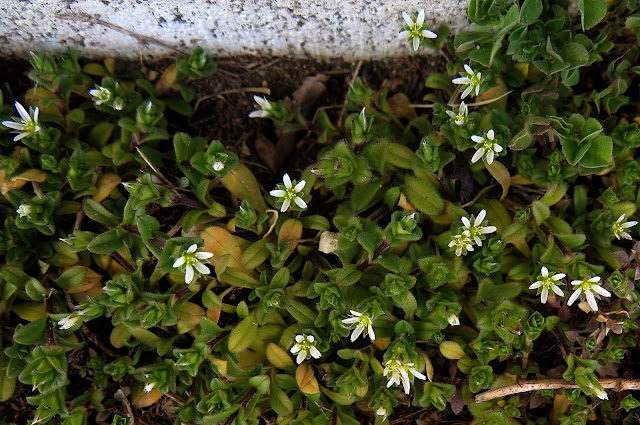OK, I've already checked off the first two entries of my spring wildflower checklist: Skunk Cabbage, first, then Coltsfoot (both found along the Spring Run Trail in downtown Saratoga Springs). Now it was time to go look for the next two entries that usually follow soon after, American Hazelnut (Corylus americana) and Spring Whitlow Grass (Draba verna). And I knew just where to find them.
Uh oh! Maybe not. I thought the deep snow would be gone by now under the powerline that runs just north of Mud Pond at Moreau Lake State Park. Dozens of American Hazelnut shrubs thrive along here, although most had been flattened by last week's heavy wet snow. When I stopped there this past Monday, I could see that the shrubs had righted themselves, but the snow still lay deep at this site.
Really deep! Would all this snow chill the site and delay the hazelnut's bloom time?
Not at all, to judge from the plethora of staminate male catkins I saw dangling from the twigs!
But of all the dozens of hazelnut shrubs I searched carefully, in only ONE of those shrubs could I find the wee little red pistillate flowers emerging from their buds. But that's all I needed to check American Hazelnut off my list of early bloomers. Ta da! (And to judge from the nuts we find ripening at this site every summer, many more female flowers will yet come into bloom.)

On to the next early bloomer, the Draba verna, which I always find at the Wilton Mall near Saratoga Springs, in a patch of barren-looking dirt that runs the length of the south-facing wall of BJ's Wholesale Club. From the driver's seat of my car, I sure couldn't see any sign of flowers growing there. But I recalled Aldo Leopold's words about Draba (in his Sand County Almanac): "He who hopes for spring with upturned eye never sees so small a thing as Draba. He who despairs of spring with downcast eyes steps on it, unknowing. He who searches for spring with his knees in the mud finds it, in abundance." So I parked my car along the road, walked over to the wall, and fell down on my knees in the dirt.

And there were the sought-after itty-bitty flowers, "in abundance"! That entire stretch of dirt was sprinkled with uncountable numbers of teeny tiny plants of Draba verna. And look, the flowers are already producing seeds! I guess that means the plants have been blooming already for some time. This plant is a really early spring bloomer!
I am aware that the wee little wildflower that Aldo Leopold waxes so poetic about was a native species called Draba reptans, but every detail he mentions about his native plant rings true for our introduced species, Draba verna: "Sand too poor and sun too to weak for bigger, better blooms are good enough for Draba. . . . Its perfume, if there is any, is lost in the gusty winds. Its colour is plain white. Its leaves wear a sensible woolly coat." Here's another photo of Draba verna that shows its tiny basal leaves in their "sensible woolly coat." And look, down in the right-hand corner are some other tiny leaves that look kind of woolly, too.
Ah yes, another little "waste place" plant called Mouse-ear Chickweed (Cerastium fontanum), a very common introduced "weed" of barren soils like this. And this tiny flower was already blooming, too. So that makes it Number 5 on my checklist of the first early-blooming wildflowers of spring.
Now on to April, and the flood of many more spring bloomers awaits!








No comments:
Post a Comment